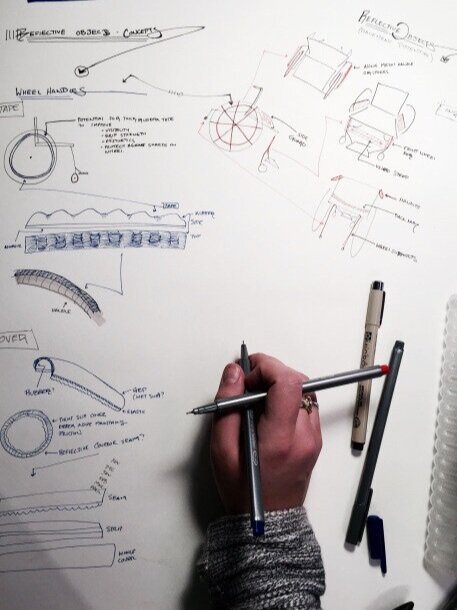It’s Not A Problem, Until It’s Yours
PARTICIPATORY RESEARCH | CO-DESIGN | PUBLIC ENGAGEMENT
This project was designed to understand & discuss the wayfinding experiences of people who use manual wheelchairs, while educating the general public on the importance of design for disability.
OPPORTUNITY
How can we use participatory research to improve safety and mobility for people who use wheelchairs in cold and freezing climates?
OUTCOME
Co-designed winter gloves that holistically address the needs of people who use wheelchairs and educational visual content which creates dialogue within the general public.
THE INTERVENTION
It is imperative that solutions are conscious not only of the end-users physical form and ability, but also of their lifestyle desires and preferences. The development of winter gloves for Amanda is both a research case study and a vector to discuss systematic problems associated with designing for disability.
THE FUNCTION OF AESTHETIC
Aesthetic plays an essential role in how we are perceived by society, and how we perceive ourselves. It is a vector to express yourself, and can be an important part of communicating where you feel you belong within a community. The lack of aesthetic diversity in the design of assistive devices is a problem too often overlooked, but must be addressed. An important part of this project was designing custom prints for Amanda to choose from in that fit her desired aesthetic. I designed these prints after interviewing her about her fashion preferences and co-creating mood boards.
The importance of aesthetic reaches beyond identity, it also influences how we understand visual content. Whether it is learning how to use a new product, or learning a new digital system, wielding aesthetics with consideration in both tangible and digital content will create more effective outcomes for end users.
USER RESEARCH
While co-designing with Amanda, I exercised qualitative research in parallel with literature reviews to both understand the nuances of the challenges faced by Amanda, while understanding the possible scale of the insights I uncovered. Methods used in this design research included empathy building exercises, bodystorming, literature reviews, affinity diagramming, mood boards, and participatory research.
It was essential in this research to not only interview and co-design with Amanda, but also put myself her her shoes. I spent several days using a wheelchair to better understand her experience. This type of empathy research also allowed my to begin iterating the glove design in the final prototype.
PROTOTYPING
To iterate this project I continued with many of the research methods used in the research phase. It became clear that using mixed materials would be essential for addressing the multifaceted needs of pushing a wheelchair in winter. I experimented heavily with different materials, construction methods, and layering on every side of this glove to account for factors such as abrasion, reflectivity, aesthetic, warmth, and splash-proofing.

























